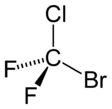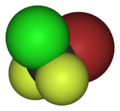Bromochlorodifluoromethane
|
|
|||
| Names | |||
|---|---|---|---|
|
Preferred IUPAC name
Bromo(chloro)difluoromethane
|
|||
| Other names
Bromochlorodifluoromethane
Halon 1211 Halon 1211 BCF BCF Freon 12B1 |
|||
| Identifiers | |||
|
353-59-3 |
|||
| 3D model (Jmol) |
Interactive image Interactive image |
||
| ChEBI |
CHEBI:84698 |
||
| ChemSpider |
9248 |
||
| ECHA InfoCard | 100.005.944 | ||
| EC Number | 206-537-9 | ||
| PubChem | 9625 | ||
| UNII |
91I5X8AJXS |
||
|
|||
|
|||
| Properties | |||
| CBrClF2 | |||
| Molar mass | 165.36 g/mol | ||
| Appearance | Colorless gas | ||
| Density | 1.799 g/cm3 | ||
| Melting point | −159.5 °C (−255.1 °F; 113.6 K) | ||
| Boiling point | −3.7 °C (25.3 °F; 269.4 K) | ||
|
Except where otherwise noted, data are given for materials in their standard state (at 25 °C [77 °F], 100 kPa).
|
|||
|
|
|||
| Infobox references | |||
Bromochlorodifluoromethane, also known by the trade name Halon 1211, or BCF, or Halon 1211 BCF, or Freon 12B1, is a haloalkane with the chemical formula CF2ClBr.
Brominated haloalkanes were first used during World War II as fire extinguisher for aircraft and tanks. Bromochlorodifluoromethane was introduced as an effective gaseous fire suppression agent in the mid 1960s for use around highly valuable materials in places such as museums, mainframe rooms and telecommunication switching centers. They were also widely used in the maritime industries in the engine rooms of ships and also in the transport industry in vehicles. Its efficiency as a fire extinguishing agent has also led it to be the predominant choice of fire extinguishing agent on commercial aircraft and is typically found in cylindrical hand-held canisters. Its advantages as a fire extinguishing agent are that it has lower toxicity than chemicals such as carbon tetrachloride and that since it is a covalently bonded compound, it does not form conductive ions, therefore being usable on electrical equipment.
Halon 1211 is an excellent fire extinguishing agent, as it is a streaming agent with low toxicity, a low pressure, liquefied gas, and effective on all common types of fires, A, B, and C. It is mainly used in portable and wheeled extinguishers, and small spot protection units for marine engine applications, and was never widely used in fixed systems like halon 1301 was.
Halo 1211 has fairly low toxicity. The lethal concentration for 15 minute exposition is about 32%.
The production of bromochlorodifluoromethane and similar chlorofluorocarbons has been banned in most countries since January 1, 1994 as part of the on ozone depleting substances. However, recycling of halon 1211 allows it to remain in use, although parts availability is limited to a few manufacturers and can be an issue. Halon 1211 is still widely used in the United States, despite its high cost, with the US Military being the biggest user, but Europe and Australia have banned its use for all but "critical applications" such as aviation, military, and police use.
...
Wikipedia


